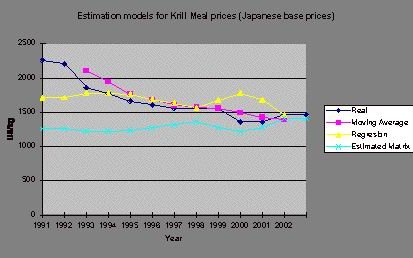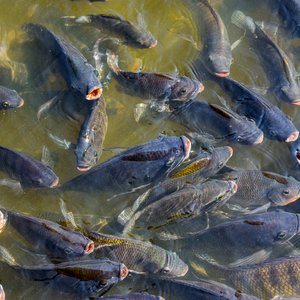Price Estimates Modeling
How Weather Phenomena (eg. “La Niña”) Alter Market Prices Estimates
An Econometric Perspective for Feed Ingredient Price Estimate.
Dried Krill Meals Case
Weather phenomena (eg. “La Niña”) do affect feed ingredient market price estimate formulations although not necessarily showing a direct relationship, but also subject to a set of other factors such as their direct competitive products and the extent (depth) of the econometrical formulation used.
A price (econometrical) mathematical predictive model for dried krill meal feed ingredient was developed (plus an associated market-positioning proposal on precooked frozen krill tail meats, in relation to the results given by the Econometrical model.) after Tharos’ 18-month work and 160-page report was concluded.
A base price was estimated considering general (standard) production costs for a dual-purpose trawler and an industry-accepted financial margin, under the assumption that a combined dried meal/frozen meat production processing effort is performed on-board a mid-aged stern factory trawler.
A detailed analysis on frozen Krill meat’s target market, possible competitors and its own medical and nutritional characteristics was also concluded. Frozen Krill meat, and its unique attributes, competes with a wide broad series of seafood products, which goes from fish like tuna and organic salmon, to shellfish like shrimp and lobster.
Comparing these products’ properties with the ones found on Krill meat, a market-positioning plan was determined, which allocates Krill meat as a product that should be more expensive than shrimp and tuna, because of its medical and functional qualities and its exclusiveness, and slightly cheaper than lobster and other well-known gourmet-like seafood’s. Frozen Krill meat indeed acts perfectly as a combined Gourmet-functional food, targeting white high-end tablecloth markets as well as medical-related foods, respectively.
In order to estimate a high-quality Krill meal FOB price, it is important to consider that Krill meal is mainly used to produce farmed salmon/trout and other fine aquaculture feeds. Accordingly, a lineal regression calculation was carried out considering Krill meal historical FOB prices and that of other ingredients that influence Krill meal prices (as they posses similar components to produce salmon feed.).
The mathematical regression calculation also considers “La Niña” phenomenon and the corresponding annual price seasonality. The influence of each factor within the regression calculation determines krill meal FOB price on a specific period of time. According to this, their influence and the predictive model are built.
In order to test the individual and global validity as well as the proposed Model stability, the regression was tested with the EVIEW econometric software.
Several other systems and mathematical methods were also used such as (a) Residuals Normality (JARQUE-BERA TEST), (b) Heteroskedasticity (WHITE TEST-CROSSED TERMS), (c) Functional Form Test (RAMSEY RESET), (d) Recursive Coefficients (Parameter Estimations with Standard Deviation), (e) Stability, (f) Durbin-Watson Autocorrelation Test and (g) Fitted VS Real, among others
The designed model needs as input prices for dried krill meal key comparative components, and the existence or non-existence of “La Niña” phenomenon. Prices of these components should be taken from the financial-future price-data exchanged in some financial markets around the world. With these inputs, under an agreed data-collection procedure, it gives the high-quality Krill meal FOB price on the specific input date.
The predictive model used for a dual-purpose trawler calculation, helps also to analyze if it is convenient to go out fishing or stay on port on those months of each catching season were raw krill is on its natural biological growing phase and it has a special color that makes krill meat commercialization rather difficult.
1 Project Description
Given the strong limitations on South Antarctic Krill (Euphausia superba, Dana) capture and Krill’s ecosystem resource status [1] added to the inherent difficulties in South Antarctic Krill’s capture and processing procedures [2] as well as other variables that directly and indirectly affect consumption and its direct effect on market prices, it is extremely useful for whoever works in this region, to have a short and mid-term price predictive model, depending on which Krill derivatives are going to be produced.
1.1 Project Definition
The research consists in the creation of a price predictive model for feed-grade dried krill meal and the subsequent determination of a market positioning formula for food-grade precooked (slightly cooked) frozen tail meat (details seen on a separate report). A mathematical model was created, able to estimate Feed-grade dried krill meal price behavior on a short and mid-term horizon. The main characteristics of these products are:
- Dried (feed-grade) krill meal: used mainly in the aquaculture industry, particularly in fine fish and farmed fish feed formulas. A relatively high protein content product [3], good natural pigments provider (mainly as astaxanthine), excellent fatty acid and amino acid combination and a high palatability feature characterize this product. These attributes give the product some of its remarkable characteristics as a feed ingredient for several farmed aquatic species. High quality krill meal is produced at-sea on-board factory trawlers from raw-whole krill, while average-low quality krill meal comes from poorly manufactured raw-whole krill as well as from food-grade shell residues and/or a combination of towing time extension-tonnage, on-board processing features (e.g. type of processing equipment), ratio raw:residues used to manufacture krill meal as well as some other post-production considerations.
- Frozen food-grade pre-cooked Krill Tail meat: destined to human consumption. As its most relevant attributes counts its mild-marine taste[4], almost negligible drip loss [5], an excellent gourmet-like and functional-like food, good on Omega 3/EPA/DHA, fatty acids and several essential amino acids contribution, as well as its pharma-usage as a way to control certain kinds of diabetes (Type I)[6], arthritis, the removal of harmful cholesterol from human veins and on diets focused on a high protein contribution.
This research emerges as an answer for the search of an analytical tool able to predict future prices for some key Krill derivatives.
1.2 Base Case Definition
While performing fishing (krill)-related consultancy activities, it is required to support cash-flow analysis as well as the overall project evaluation on a good set of analytical tools. These are based on Tharos’ long experience in the krill industry as well as on its own on-site market research. Such analytical tool(s) must have a good prediction capability to make the resulting data suitable to use as a good & solid estimation instrument working on hard (as well as soft) parameters.
A detailed cost-structure analysis was developed for a dual-purpose production process, in order to have a better understanding of the Krill industry and get solid measurement parameters that lead us towards accurate price estimations both for food-grade Krill tail meat and feed-grade Krill meal,
To accomplish this, an average operational cost-structure for a dual-purpose trawler was used. These vessels capture and process Krill obtaining various krill products such as tail meat, dried meal, whole frozen, oil and hidrolizates. A three-product-scenario cost structure was analyzed, combining Krill Tail meat, High Quality (HQ) and Low Quality (LQ) Krill meal. According to this, a costs matrix was developed.
This matrix works based on trawler operational days’ and its daily-average-capture figure. From this, season’s total captured tonnage [7] is calculated versus the desired share of such catch destined either to food-grade meat and/or feed-grade dried meal. Subsequently, production quantities of tail meat, high & low quality meals are obtained, all of them manufactured with a minimum targeted efficiency and properly managing processing residues.
From the season’s total production figure and each product corresponding market price, total FOB sales are obtained starting this way with the financial feasibility analysis, achieved knowing the cost structure and total sales.
All company-expenditures are included in the cost analysis, either fixed or variable costs, which have been subdivided in two categories: On-board and Off-shore costs
In order to obtain each unitary cost, a relevant consideration must be made; if low quality Krill meals are produced as a Krill tail meat process’ by-product or not.
Trawler operational season extends for approximately seven months, based on weather, targeted end-product quality and Krill’s biological growing-cycle aspects. Certain months see mainly high quality dried meal being produced while on other months; production is distributed between dried meal and tail meat.
According to the above, a cost-sensibility analysis was performed considering salary, bunkers and lubricants as the most relevant ones, while other costs are left to “ceteris-paribus” criteria, which are more stable and/or their relevance within the total cost structure is less important than the mentioned ones.
Cost-sensibility analysis was performed both for the period when only high quality meal is produced, and when a big share of the daily capture is destined to tail meat (the balance used on meal production). In both cases, higher and lower cost-scenarios were analyzed. Using this criterion, it was possible to obtain the highest and the lowest cost level for each product.
3 Price predictive and explicative model development
Krill meal can be processed either as a direct-target product or as a tail meat production by-product. Krill meal is mainly used as a source of proteins, vitamins, lipids, free of dioxins and other heavy metals ingredient, also adding natural pigments used in the animal feed industry, particularly for the aquaculture industry.
One of the most important krill meal features is its high palatability, resulting in a very strong feed-attractant (as an ingredient). Feed mixes containing Krill meal will be much more palatable to farmed species resulting on higher feed conversion rates.
3.1.2 Substitutes Determination
Given the previously mentioned krill meal features, the following products are seen as the most relevant krill meal substitutes, considering protein, pigment, lipids and other attractant contents:
· Pigments
1. Artificial pigments (Carophyll Pink and Carophyll red)
2. Natural Pigments: Algae (basically Phaffia Rhodozimma and its derivatives developed by Igene)
The pigment market is widely dominated by DSM, owning patents of many of the most used pigments in the aquaculture industry, remarkably Carophyll Pink and Carophyll Red [8].
· Proteins
1. Fish meals (white & brown)
2. Crustacean meals (red)
3. Vegetable
Within the aquaculture industry, protein is mostly obtained from fish meals manufactured from pelagic species coming primarily from Mackerel, Hake, Pollock and Squid found in North European, Peruvian and Chilean coasts, being widely used as a farmed fish protein source.
On crustacean sources, the most relevant ones are shrimp and Prawns (wild caught Pandalus borealis and Heterocarpus reedi species), and Chilean crustacean meals (Cervimunida johni & Pleuroncodes monodom species). These have similarities and differences with Krill meal, among them a different (and less effective) protein (amino-acid), fat (fatty-acid) and pigment (astaxanthin) profile. These meals pigments’ don’t have the bioavailability index that Krill meal’s astaxanthin has on fish fillets [9]. Another important factor is krill meal’s palatability effect.
Vegetable proteins are seen as bearing a great potential as an aqua-grade feed protein source (cost and availability). All this combined, with the expected continuous aquaculture-industry growth rate, creates the need for new protein sources. Nowadays, vegetable proteins can’t be added in excess of certain concentrations because of their mineral absorption problems, low palatability, anti-growth factors presence, etc. New technologies are being developed to solve these problems
· Lipids: Fish Oil
· Attractants: Glucanes
3.1.3 Krill meal Market Prices Evolution
This report is the first of a series of research focused in the determination of a reliable feed ingredient price predictive model [10]. Therefore only three methods were plotted for this purpose for the 1991-2002 period:
- Mobile average, as a way to estimate future prices: A fixed number of prices, previous to the one being determined, are taken in consideration while the average of these is the final predicted price. The number of prices needed to predict the actual one secures the sensitivity of this model. The most important limitation of this method is that it cannot predict long-term prices as it only gives, with a relatively good correlation, the price of one subsequent period.
- Added value of its components, on Krill meal three main components’ supposedly used to explain its market value: Protein, lipids and Astaxanthin (pigment). The final predicted price weighs substitute-product prices according to each equivalent concentration found in Krill meal.
- Component-based linear regression, a regression calculation was run using as parameters; fish meal, fish oil and Carophyll Pink spot prices. This regression is then analyzed through F and t Tests in order to determine how exact this regression is for the Krill meal price predictive model purpose.
From these three estimation models the following figures were obtained:
Figure 1: Estimative models comparison.
From this figure it can be observed that the selected regression variables are not explaining Krill meal prices for the 1991-2002 period.
3.1.4 Krill Meal Situation (1997-2003)
From the mobile average, linear regression and estimated matrix comparative figure it can be observed that Krill meal prices have had a descending trend as the gap between the estimated matrix and the real price decreased rapidly in the analyzed period, more towards the six-year term 1997-2002. Krill meal price behave like the weighed sum of its components prices.
In other words, seems as if Krill meal falls on a commoditization-process curve, possibly being difficult to sustain its actual market value. Regression calculation’s initial goal was to find out how substitute-product prices affect Krill meal market prices. Statistical tests show that these variables had little or no significance in Krill meal prices for the 1991-2002 period (monthly samples)
Nevertheless, a new calculation attempt was done for the period 1997-2002, where Krill meal behaves more as a commodity ingredient. There are many other factors that sustain this supposition such as the entrance of new processors and new and better pigment substitutes, among other factors.
These factors led into a sustained drop of the Krill meal prices. This situation required a new statistical test that could satisfactorily explain this phenomenon.








